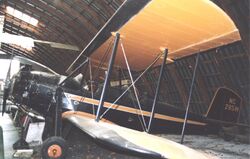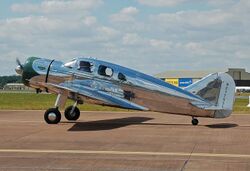Company:Spartan Aircraft Company
 | |
| Type | Incorporated |
|---|---|
| Industry |
|
| Fate | Dissolved |
| Predecessor | Mid-Continent Aircraft Manufacturing Company |
| Founded | 1928 |
| Founder | William G. Skelly |
| Defunct | 1961 |
| Headquarters | Tulsa, Oklahoma , United States |
Key people |
|
The Spartan Aircraft Company was an American aircraft manufacturing company, headquartered on Sheridan Avenue near the Tulsa Municipal Airport in Tulsa, Oklahoma.[1] Previously known as Mid-Continent Aircraft Company, the company had been reorganized under the Spartan name in 1928 by oil baron William G. Skelly—and operated until 1961, manufacturing aircraft, aircraft components, and recreational vehicle trailers. The company was known for the luxurious Spartan Executive aircraft produced in the late 1930s and early 1940s.
J. Paul Getty acquired the company from Skelly in 1935. After World War II, Getty ended aircraft production and converted the company to manufacturing trailers under the Spartan Manor brand—subsequently ending all production in 1961.[2]
History
Early history
Successful oilman William G. Skelly purchased the struggling Mid-Continent Aircraft Manufacturing Company of Tulsa in January, 1928. He renamed the company Spartan Aircraft Company, reorganized it financially and began the Spartan School of Aeronautics.[1][3] Skelly continued to support the venture during the early years of the Great Depression, while it began producing a line of airplanes. The economic depression strained Skelly's personal finances, and in 1935, J. Paul Getty purchased a controlling interest in the company from Skelly. At the beginning of World War II, Getty assumed direct control of the company operations. He expanded manufacturing by making sub-assemblies for warplanes and opened branches of the Spartan School of Aeronautics in Miami, Muskogee and Ponca City, Oklahoma.[2]
Early aircraft
The first aircraft produced by the Spartan Aircraft Company was the Spartan C3 open-cockpit biplane. Built in 1926 (first flight 25 October 1926), the C3-1 was the first of a series of variants of the design for flight schools, sportsman aviators, and Fixed-Base Operators (FBO). The Spartan C3-225 was the last early biplane design produced by the company. At least 160 C-3 aircraft were built, using various engines.[4]
1930 saw the production of Spartan's first monoplane design, the Spartan C2-60. Designed for the sportsman flier, the C2-60 was a lightweight design with a small 60 h.p. engine. Using many of C2-60's characteristics, Spartan produced the heavier, more powerful C2-165 low-wing monoplane. Unpopular with the military due to the view-obstructing low-wing design, the C2-165 was primarily used for civilian training purposes.
Improvements in Spartan's manufacturing and technology was evident in the 1930 Spartan C4. The C4 was a high-wing monoplane designed for low-maintenance and high-comfort. The Spartan C4 was designed to accommodate large engines of 230 h.p. and more.
Spartan Executive 7W
The Spartan Executive Model 7W was a result of founder William Skelly's vision for an aircraft designed to accommodate the luxury and performance expected by wealthy people. Powered by a 450 h.p. Pratt & Whitney Wasp Jr. engine, the Executive was Spartan's first attempt at an all-metal aircraft design using monocoque technology. The large engine and aerodynamic airframe allowed for a then-remarkable 200-mile (320 km) an hour cruise speed, a range of over 1,000 nautical miles (2,000 km) and a 25,000 ft (7,600 m) service ceiling. Thirty four 7W aircraft were produced.[5]
Based directly on the high-performance design of the civilian Spartan 7W, a version of the aircraft was developed to meet military needs for high-performance reconnaissance and training aircraft. The re-designed model was named the Spartan Zeus 8W and featured a powerful Pratt & Whitney Wasp 600 h.p. engine.
End of aircraft manufacturing
The last aircraft to be developed by the Spartan Aircraft Company was the Spartan NP-1 biplane. The NP-1 was a throwback to earlier aircraft in appearance, though the technology used in the aircraft's construction was certainly more advanced than the wire and fabric used in Spartan's early biplane designs. Built as a United States Navy trainer, the Spartan NP-1 featured a lightweight open-cockpit construction with a Lycoming R-680-B4C 225 h.p. engine.
Trailercoaches
After the ebb of personal aviation and the increased competition in the aircraft business following World War II, owner J. Paul Getty and Spartan upper-management redirected production to focus on the demand for housing and leisure.[2] Using the same internally braced and space-saving monocoque design of the Spartan Executive 7W, the company produced its first all-metal travel trailer. The company followed previous design strategies, offering lavish and full-featured trailers. Through the 1940s and 1950s, Spartan produced what some referred to as the "Cadillac" of trailers, commanding prices higher than $4000.[6] Spartan produced over 40,000 trailer homes before ending production in 1961. Given an average home cost in the United States at the time of $8000,[citation needed] Spartan trailers were a discretionary purchase for the wealthy.[7]
Factories close
After 33 years of manufacturing aircraft and trailers, the Spartan Aircraft Company closed its manufacturing facilities and entered the insurance and financial business under the name Minnehoma Insurance Co. The Spartan name was sold to the Spartan School of Aeronautics, which operates today under the name Spartan College of Aeronautics and Technology.[8][7] However, Pratt and Whitney R2000 aircraft engines continued to be overhauled under the nominated company the Spartan Aircraft Company as late as 1970 according to Department of Defense appropriations listings [9]
Aircraft
| Model name | First flight | Number built | Type |
|---|---|---|---|
| Spartan C3 | 1926 | ~122 | Single engine open cockpit biplane trainer |
| Spartan C4 | 1930 | 7 | Single engine cabin monoplane utility aircraft |
| Spartan C5 | 1930 | 4 | Single engine cabin monoplane utility aircraft |
| Spartan C2 | 1931 | 56+ | Single engine open cockpit monoplane sport airplane |
| Spartan 7W Executive | 1936 | 36 | Single engine cabin monoplane utility aircraft |
| Spartan 8W Zeus | 1937 | 4 or 5 | Single engine cabin monoplane trainer |
| Spartan NP | 201 | Single engine open cockpit biplane trainer | |
| Spartan 12W Executive | 1 | Single engine cabin monoplane utility aircraft |
References
- Notes
- ↑ 1.0 1.1 Donald M. Pattillo. A History in the Making: 80 Turbulent Years in the American General Aviation Industry. p. 20.
- ↑ 2.0 2.1 2.2 Tolman, Keith. Encyclopedia of Oklahoma History and Culture. "Spartan Aircraft Company"."Spartan Aircraft Company". http://digital.library.okstate.edu/encyclopedia/entries/S/SP005.html.
- ↑ "Announcing the...Spartan". Aero Digest (Aeronautical Digest Publishing Corporation) 12 (4): 496. April 1928. http://archive.org/details/aerodigest1219unse/page/496. Retrieved 22 July 2021.
- ↑ Simpson, 2001, p. 517
- ↑ Simpson, 2001, p. 518
- ↑ "Spartan History". http://www.spartantrailer.com/history.html.
- ↑ 7.0 7.1 Tulsa Gal Website: "Spartan Aircraft - Trailercoaches" November 10, 2010. Accessed June 21, 2011.[1]
- ↑ Spartan.edu
- ↑ Department of Defense Appropriations for 1970: Hearings Volume 4, Part 2 Page 554
- Bibliography
- Simpson, Rod (2001). Airlife's World Aircraft. Airlife Publishing Ltd. ISBN 1-84037-115-3.
External links
 |



